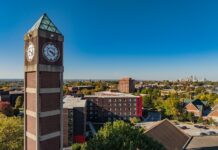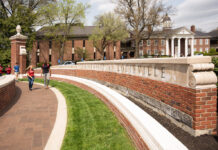That’s what President James Ramsey and Provost Shirley Willihnganz wrote to the University of Louisville community three days after the university sustained the worst flooding in its history.
When the sky turned black and rain began to pour at 7:45 a.m., Aug. 4, 2009, no one expected that by 9:15 a.m., portions of Belknap Campus would be under several feet of water, and more than a foot of water would be in a Health Sciences Center building. People never could have imagined that parking lots would look like lakes, car roofs serving as tiny metal islands; that campus and surrounding city streets would be rivers; and that emergency personnel would have to evacuate some employees from a building by boat.
The clouds stopped and dumped on us, said Larry Owsley, vice president for business affairs. What it dumped, according to Metropolitan Sewer District, was a record 7.2 inches of rain in 78 minutes. Reports are that another inch fell during the day.
Despite the extent of the flooding and the damage to property, only one injury was reported when an administrator slipped and broke her wrist, according to the Department of Public Safety.
Our folks responded great as they answered calls ranging from flooded roads, rising water, stalled vehicles and power outages, said Kenny Brown, UofL’s assistant police chief. DPS called in off-duty officers to help respond to the flood-related calls.
We were very fortunate there were no critical injuries, Owsley said, noting that there was potential for drowning, electrocution, broken bones and other injuries. The first day’s priority was just making sure we got through the storm event itself, and the success in doing that is something he credited to UofL’s ongoing emergency planning process.
It is the personal part of the flood that Ramsey thinks of first, looking back from the vantage point of a year. When someone mentions that day, he said he immediately thinks of employees stranded in a building.
That was the case in the Houchens Building on Belknap Campus. About 50 employees there had to be taken out by boat. Staff in the Fairfax Building near Old Eastern Parkway sloshed through several feet of water to the nearby steam-chill water facility when water came in the building. Other employees and students were drier but could not leave their buildings because water surrounded them.
A torrent burst through a lower-level door at the College of Business, having come through an underground tunnel that connects the College of Business, School of Music and College of Education and Human Development buildings. At its peak, the water level at the College of Business reached three feet.
Education was the hardest hit of all academic units. Nine feet of water filled the CEHD basement.
Downtown, a foot and a half of water poured into the lower level of the School of Public Health and Information Sciences, much to the dismay of employees there who had just seen completion of its renovation.
In all, 92 of the university’s 150 buildings received some damage from the flood, and the university submitted claims on 73 Belknap Campus buildings and 19 Health Sciences Center buildings in amounts that ranged from less than $100 to as much as $5.6 million, Owsley said.
The total claim amount for buildings and contents was $20,949,000; insurance covered all but about $2,500, he added.
That is phenomenal, he said, but largely is a credit to the documentation put together by Physical Plant and Risk Management staff.
The insurance adjusters praised them to no end for how well they documented our losses, he said, noting that quick action after the flood to put claim information and forms online helped the documentation process.
Perhaps what is even more phenomenal is that summer session continued and the fall semester started on time, although some classes were moved to other buildings. Belknap Campus and SPHIS closed entirely — just for the day after the flooding.
A lot of people pulled together and put in long hours to make the recovery happen, Owsley said.
But even though all services were in place and the fall schedule started on time, things weren’t entirely back to normal when students returned Aug. 24.
At the College of Education and Human Development, water levels to the basement rafters presented one problem, but the entire building was made uninhabitable when diesel fuel leaked into the water and contaminated the air system. CEHD faculty and staff found temporary quarters in several locations — some off campus — and classes that normally met in that building were moved elsewhere in what was a logistical challenge beyond compare at a university that already faces a shortage of classroom space. The building reopened in November.
Staff — in fact entire offices — from the Houchens Building – admissions, financial aid, registrar and others — had to move. Offices in Strickler Hall opened their doors to many of them until they could return to Houchens in September.
Staff from Fairfax Building dispersed across campus, with some landing in a triple-wide trailer behind Speed School and others sharing a tiny Grawemeyer Hall conference room table for most of the semester.
The recovery was inspirational, Ramsey said. It just proved how resilient we are at the University of Louisville. We … exceeded everyone’s expectations.
While this was the worst flooding UofL has experienced, it was not the first time the university — especially Belknap Campus — had flooded.
We have had flooding over the years, and every time we have tried to diagnose the flooded areas and take preventive actions, Owsley said.
That was the case this time, too. Some of those measures include building up steps to prevent water from coming under outside doors, improving backflow preventers in campus drains, installing sump pumps in places where water might build up and changing outside landscape so it holds back water, building an earthen berm on the south side of the College of Business to divert water and re-hanging the tunnel door into the COB lower level so it opens into the tunnel. At SPHIS, future flood prevention meant installing a concrete wall in place of glass walls that gave way to the water.
UofL also is working with Metropolitan Sewer District on other ways to keep runoff out of the storm sewer system.
When you have that much rain in that short a time, the sewers — which are large sewers — just back up and there’s no place for the water to go, Owsley said.
So UofL is looking at diverting water from downspouts to an underground aquifer and creating rain gardens and green roofs.
The measures that the university has taken so far and plans to take may help offset future flooding, but that doesn’t mean that people who were on campus Aug. 4, 2009, don’t pay a little more attention to the weather than they once did.
I have had people call me when it starts to rain, Owsley said. People are more aware of the elements.





























